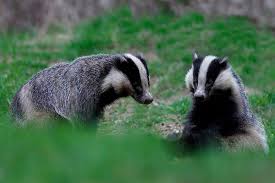The (European) badger (Meles meles) is the largest species (family of Mustelidae) who is still alive in the wild. This omnivore is up to fourteen years in the wild, captive to sixteen.
 He has distinct black and white hairs that do make him look gray. The underside and legs are black. The head, ears and tail are white. From the muzzle two broad stripes walk over the eyes to the ears and occiput. The hair was used for shaving brushes.
He has distinct black and white hairs that do make him look gray. The underside and legs are black. The head, ears and tail are white. From the muzzle two broad stripes walk over the eyes to the ears and occiput. The hair was used for shaving brushes.
Badgers are 68 to 80 centimeters with a tail of 12 to 18 centimeters. Females are slightly smaller. They have a shoulder height of about 30 centimeters. They weigh (depending on region, gender and season) around 7-14 kg and have a waddling gait, poor eyesight but an excellent nose and good ears.
The musk gland under the tail they use to mark territory and each other.
They eat earthworms, also insects, fruits, hazelnuts, tubers, grains, clover and grass, amphibians (frogs) and small mammals (rabbits, mice, voles, moles), ground-nesting birds and their eggs, carrion and even hedgehogs and wasps (larvae).
Their muscled forelimbs have large claws with five toes with firm, non-retractable nails. With those they make underground burrows in slopes and hills. The excavated sand and debris are forming large mine dumps for the entrances. The badger brings clean nesting material, clamped between forelegs and chin, walking backwards into the den. Stones of more than 1 kilo he works out.
In a burrow are several rooms. The tunnels are ten to twenty meters long and have a diameter of at least thirty centimeters.
The burrow is used by generations of badgers over a period of decades and expanded. She has three to ten entrances, which are ten to twenty meters apart.
They stay a lot in their burrow, in winter even more. They do not hibernate, but have a winter rest with a lot of sleep and lack of moving.
In a burrow five to eight adults live with their offspring that are born in January or February. Each farrow a badger female receives a five newborns.
Sometimes rabbit or fox are staying in the same tunnels.
Not far from the main burrow is usually a second burrow, which they often use in the summer as a kind of retreat.
Latrines (holes of approximately 10cm) are sometimes close to the entrances, but mostly as markings for the territory borders.
For decades, badgers were contested as pests.
In South Limburg was until 1960 badger meat sold on the street and even more recent would secretly still jars with badgers fat with supposed medicinal properties against many miners ailments have been for sale.
In France are still badger setts excavated, there are even competitions (concours de deterrage de blaireaux) organized in digging badgers.
In recent years there has been a recovery of the badger population by their protection. However, still many die as road kill. (In 2008, in South Limburg a copy of up to 22 kg!)
